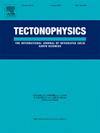EMAG2-v3揭示的东喜马拉雅构造的地壳磁结构及其意义
IF 2.7
3区 地球科学
Q2 GEOCHEMISTRY & GEOPHYSICS
引用次数: 0
摘要
东喜马拉雅合带(EHS)位于印度板块和亚洲板块碰撞的前沿,代表了青藏高原东南缘地形崎岖、构造变形复杂的地区。一个长期的争论围绕着两种构造演化模式:“平板压痕”和“构造动脉瘤”。本研究通过对EMAG2-v3地壳磁异常的分析和反演,获得了三维地壳磁结构。通过将磁性结构与岩石磁化率相结合,确定了粗糙的地壳岩性结构,建立了简化的两阶段演化模型。结果表明,EHS的核心存在一个强磁体,特别是在Namche Barwa峰和Gyala Peri峰区域。该强磁体的三维空间特征表明,EHS下方的深部物质正从高原内部向东南方向隆升。地壳磁性和岩性结构均支持“构造动脉瘤”演化模型。将地震危险区确定为强磁体边界周围的区域,特别是靠近强磁体一侧的区域,以南切巴尔瓦峰和Gyala Peri峰为中心。本文章由计算机程序翻译,如有差异,请以英文原文为准。
Crustal magnetic structure and implications for the Eastern Himalayan Syntaxis revealed by EMAG2-v3
The Eastern Himalayan Syntaxis (EHS) is located at the forefront of the collision between the Indian and Asian plates, representing the region with the most rugged terrain and intricate structural deformations along the southeastern margin of the Tibetan Plateau. A long-standing debate has revolved around two modes of tectonic evolution: “flat slab indentation” and “tectonic aneurysm”. This study, employing analysis and inversion of the EMAG2-v3 crustal magnetic anomalies, has obtained a 3D crustal magnetic structure. By integrating magnetic structures with rock susceptibilities, the rough crustal lithological structure is determined, and a simplified two-stage evolution model is established. The results reveal the presence of a strong magnetic body in the core of the EHS, particularly in the region of Namche Barwa Peak and Gyala Peri Peak. The 3D spatial characteristics of this strong magnetic body indicate that deep-seated materials beneath the EHS are uplifting from the plateau interior to the southeast. Both crustal magnetic and lithological structures support the “tectonic aneurysm” evolution model. The seismic hazard zone is identified as the region surrounding the boundary of strong magnetic body, particularly on the side adjacent to the strong magnetic body, with Namche Barwa Peak and Gyala Peri Peak as its center.
求助全文
通过发布文献求助,成功后即可免费获取论文全文。
去求助
来源期刊

Tectonophysics
地学-地球化学与地球物理
CiteScore
4.90
自引率
6.90%
发文量
300
审稿时长
6 months
期刊介绍:
The prime focus of Tectonophysics will be high-impact original research and reviews in the fields of kinematics, structure, composition, and dynamics of the solid arth at all scales. Tectonophysics particularly encourages submission of papers based on the integration of a multitude of geophysical, geological, geochemical, geodynamic, and geotectonic methods
 求助内容:
求助内容: 应助结果提醒方式:
应助结果提醒方式:


